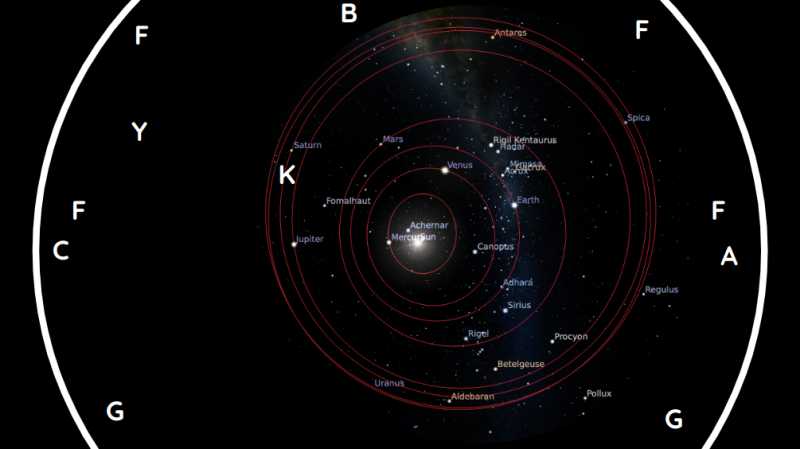The Planets the Earth and Moon
Table of Contents
There are several things to note concerning the planets.
- They all tend toward the center of the stellar gravitational territory that contains them.
But they can never arrive at those centers since the sun and stars already occupy the center.
Assume that saturn follows the orbit of the air-aether at orbit K

- If
saturnhad a bit more force to continue its motion in a straight line relative to the air-aether around it, then it would go farther towards outer orbitY
- From there,
saturnwould move more towardsFthe faster and smaller the air-aether are atYcompared toK. - Those air-aether at
Ywill give more force tosaturnto make it pass beyondFwithout stopping, and enter into another territory. - Instead of being a planet, it would become a comet.
No planet can stop anywhere in that vast space between orbit K and the circumference of the heaven FGGF through which the comets pass.
The planets necessarily cannot have more force to continue their motion in a straight line than those of the air-aether at K, when those planets move with the same agitation along with these air-aether.
All bodies that have more are comets.
At orbit K, planets have the same force as the surrounding air-aether. Those which have more force are comets.
Assume that saturn has less force and are slower than the air-aether surrounding it.
- This makes the air-aether around it push it down towards the orbit of
jupiter. - Once at the orbit of
jupiter,saturnwill stay in that orbit if its speed and force matches that of the surrounding air-aether.
But if saturn were at the orbit of jupiter and has even less force or speed than the air-aether there, it will again be pushed by the air-aether closer to the sun near the orbit of mars.
- This will continue until it is in an orbit where its force and speed matches that of the surrounding air-aether.
Thus, there are diverse planets at varying distances from the sun:
- Saturn
- Jupiter
- Mars
- Earth
- Venus
- Mercury.
Of these, the lowest and least massive can reach to the sun’s surface.
But the highest or farthest can never pass beyond orbit K.
Orbit K is so small compared to the total territory of the solar system. You could think of orbit K as the middle area of the solar system.
The air-aether beyond orbit K or Saturn are much smaller than the planets. Yet they have more force than the planets.
This is because this force does not depend solely on the quantity of matter in each body, but also on its surface area.
Assume that 2 bodies are moving equally fast. Body A has twice the density and size of body B.
If the surface area of Body A became larger, then it would become slower because it would meet more resitance.
The air-aether particles are more or less completely spherical.
- Spheres have the most matter within the least surface area.
The planets, on the other hand, are made up of earth-aether with very irregular shapes and sizes.
- They have large surfaces relative to their density.
Thus, the planets can have:
- a greater area to volume ratio than most of these regular air-aether particles
- a smaller area to volume ratio than some of the smallest air-aether that are closest to the center of the territory.
Given 2 air-aether balls, the smaller ball will have more surface per matter than the large ball.
For example, make 3 clay balls.
- Ball 1 and 2 have the same amount of clay, but Ball 2 is compressed to half the size of Ball 1.
- Ball 2 would roll farther than Ball 1
- Ball 3 will have much less amount of clay packed into a much smaller ball
- Ball 3 would not roll farther than Ball 1
- Ball 1 can move farther the more it is compressed and less farther the less it is compressed
This is why of the planets within orbit K:
- are at varying distances from the
sun - the ones at the outer parts have the largest size, and the most solid and massive cores